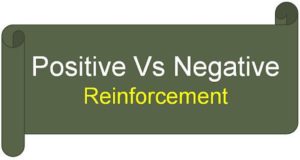 Behavioral issues can begin at a young age and carry on through a person’s entire life if not dealt with accordingly. Reinforcement is what we use to help increase the probability that a behavior will occur with the use of a stimulus or item as soon as the required response or behavior is shown. If this doesn’t make sense, in simple terms; it is a reward for a certain behavior.
Behavioral issues can begin at a young age and carry on through a person’s entire life if not dealt with accordingly. Reinforcement is what we use to help increase the probability that a behavior will occur with the use of a stimulus or item as soon as the required response or behavior is shown. If this doesn’t make sense, in simple terms; it is a reward for a certain behavior.
Reinforcement procedures have been commonly used with children, teenagers, the elderly, animals, and for many psychological disorders. The reinforcement used can be either positive or negative, each having different outcomes completely. It can be quite difficult to differentiate between positive and negative reinforcement, which can often cause problems.
Positive Reinforcement
Positive reinforcement is an extremely powerful tool that has proven to help change and create new behavior. It works by rewarding the person with a motivating item after the behavior is achieved, making it more likely to happen again in the future.
An example of positive reinforcement is: A child receives money for doing chores.
Negative Reinforcement
Negative reinforcement is where instead of being rewarded with an item for making positive choices, and item or stimulus is removed after a specific behavior is shown.
The likelihood of the behavior occurring again is increased because of removing the negative association, however negative reinforcement should not be seen as punishment (which decreases a behavior) but should be seen as a way to increase a behavior by removing a negative association.
An example of negative reinforcement is: A teenager dislikes when her parent is constantly reminding her about cleaning her bedroom, or how messy her bedroom is. If the parent removes or decreases the reminders, it is more likely the teen may clean her room to avoid hearing the reminders.
The result you are seeking for negative reinforcement is to increase a behavior by removing the negative association. The result you are seeking for positive reinforcement is adding a positive association to increase a response.
Punishment
Punishment is usually seen as an unpleasant stimulus or a harmful consequence, however this is not necessarily the case. Punishment is where a consequence directly follows an action which reduces the frequency of the particular behavior. Comparable to reinforcement, a stimulus or reward can be added (positive punishment) or taken away (negative punishment).
Just like reinforcement, there are also two types of punishment: Negative and positive. Also, like reinforcement, it can be difficult to determine the difference.
What is Positive Punishment?
Positive punishment is when you offer an unpleasant consequence once an undesired behavior is shown, which will make the behavior less likely to happen again.
An example of positive punishment: A child has a tantrum and throws himself onto the ground, hitting his head hard on the floor (behavior) and feels pain (aversive stimulus).
What is Negative Punishment?
Negative punishment is when a stimulus is removed after an undesired behavior is shown, which will make the behavior less likely to happen again.
An example of negative punishment is: A teenager bullies another teenager at school (behavior). The bully is removed from the school (reinforcing stimulus removed).
The purpose of punishment is to reduce the undesired behavior. Although there are negative and positive ways to enforce punishment, remember that the desired result is the same.
Fine-tuning how to positively and negatively reinforce situations with your family members is one of the most difficult parts of parenting. Being on the same page as your partner will ensure the same results are being aimed for and achieved.
